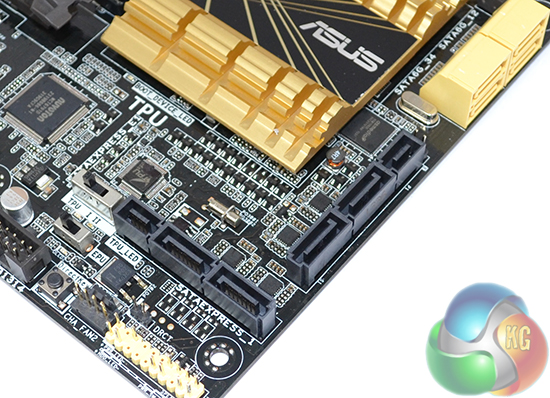So there we have it; SATA Express looks to be the solution that can re-ignite the flame of innovation for SSD vendors. Asus has proven that a two-lane, 1GB/s storage connection is viable for use with current PCIe 2.0-equipped platforms. And there's no reason to rule out PCIe 3.0 implementations which provide 2GB/s of bandwidth.
There's no denying that SATA Express isn't perfect. Although still being finalised, the connector is bulky and cumbersome. Connections are limited to two PCIe lanes which, even when using Gen 3 connections, look to already be a limiting factor in the very near future, as proven by SandForce SF3700-equipped devices.
But what SATA Express does well is offer a solution which, quite frankly, destroys SATA 6Gbps in terms of bandwidth. And it's the interface's relatively simple design that will allow it to enter the market rapidly, unlike it is suggested the theoretical SATA 12Gbps would have.
Backwards compatibility is nice, but for the enthusiast consumer, SATA Express looks to be the long-awaited worthy solution for high-speed storage devices. PCIe devices have gained popularity in the high-speed storage segment, but many products have a number of shortfalls – taking up a motherboard slot and hit-or-miss compatibility with technologies such as TRIM (although this has been all but wiped out), to name just a few.
With SATA Express, enthusiasts aren't limiting their graphics options by using up valuable PCIe slots; the storage devices can be housed in a standard chassis bay, leaving ample room for multi-GPU configurations. And drive vendors are less limited in terms of physical dimensions; there's no reason why a thick 2.5″ or 3.5″, multi-PCB SATA Express SSD can't be provided for desktop enthusiasts.
Perhaps the biggest question regarding SATA Express is one that has yet to be answered. How will it fair in regard to adoption? Hopefully Intel will select express delivery for SATA-E, although whether or not that will be the case is still unclear. Early information suggested the SATA Express would feature on the 9-series chipset, but more recent reports suggest that the semiconductor giant will not be providing SATA Express on its upcoming chipset, opting instead for the PCIe-fed M.2 form factor.
As already mentioned, SATA Express adoption in the near future could be at the discretion of motherboard vendors, unless Intel adds native support to its upcoming chipset. And then there's the question mark surrounding widespread adoption from SSD vendors. Regarding SSD vendors, there could be some hope for SATA Express devices in the near future; we contacted ADATA who confirmed that they would be releasing SATA Express drives as soon as the controllers are ready.
M.2 could act as a barrier on the road of SATA Express adoption. Information suggests that, on the 9-series chipset, the SFF interface will use two PCIe 2.0 lanes to provide 1GB/s transfer speeds. That's the same as current (and soon to come, possibly) iterations of SATA Express. Both SATA-E and M.2 will offer support for the NVMe specification, too. And M.2 devices have already started trickling onto the market.
Despite the hurdles, SATA Express still has its place on the computing scene. Only so much NAND can be physically squeezed onto an M.2 device, after all, and high density chips are not priced linearly proportional to their capacity increase. And with the use of PCIe 3.0 lanes, SATA Express could offer double the bandwidth of suggested M.2 implementations. High-speed external drives could also make use of the SATA Express interface, especially those equipped with Thunderbolt or the upcoming USB 3.1 connector.
It's refreshing to see a motherboard vendor such as Asus taking a bold step and offering support for an upcoming interface. Yes, this is only a technology demo board, but it shows that the company has the future of storage in its thoughts.
To conclude, SATA Express looks to be the next logical step for desktop storage devices. M.2 will look after the SFF and mobile scenes, but when it comes outright speed and high capacities on the desktop side of the consumer market, SATA Express should have us covered.
You can discuss this article on our Facebook page, over HERE.
 KitGuru KitGuru.net – Tech News | Hardware News | Hardware Reviews | IOS | Mobile | Gaming | Graphics Cards
KitGuru KitGuru.net – Tech News | Hardware News | Hardware Reviews | IOS | Mobile | Gaming | Graphics Cards




Great read there, looking forward to the next generation boards.
just devote a pcie slot to storage and just have pcie style SSD/HDD
I hope the new range of motherboards have this technology available, its a great idea. I use a lot of drives in RAID to get the max speed.
When are these going to be available?
That asus card takes up a lot of space, would be an issue with a system containing multiple GPU’s. the board looks great though, id be interesting in selling my current asus board and getting a new one this year if this gets adopted.
Fascinating read, spent the last hour on this article. thanks Kitguru.
The only issue will be the cost of adoption this year, the ASUS card is quite expensive still, although I see Amazon should have stock in soon.
I did enjoy the read, learned a few things as well, which is always good.